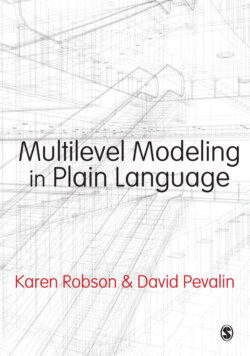Читать книгу Multilevel Modeling in Plain Language - Karen Robson - Страница 10
На сайте Литреса книга снята с продажи.
What are the advantages of using multilevel models?
ОглавлениеWell, as the name implies, multilevel models are equipped to analyse multiple levels of data. The information about individual and group characteristics is retained and separate estimates are produced for both. Adjustments are made for correlated error terms and for the different degrees of freedom (i.e. Level 1 degrees of freedom and Level 2 degrees of freedom). Perhaps most importantly, we are also able to do cross-level interactions so that we can explain how Level 1 predictors affect our dependent variable according to different contexts (Level 2 predictors). Additionally, we can look at how Level 1 predictors interact with each other and how Level 2 predictors interact with each other. And because multilevel modeling is just an extension of OLS, much of the knowledge you already have about OLS will come in handy for model-building and the interpretation of the results.
We now show that using regular single-level regression techniques to address multilevel issues is fraught with problems. The main problem is that your results are likely to be filled with errors that originate from various violations of the regression assumptions. In many cases, we get poorly estimated results that will be statistically significant, leading us to reject our null hypotheses when we really shouldn’t be rejecting them. In other words, finding associations where none exist, erroneous conclusions, and possibly leading to ineffective policies.
